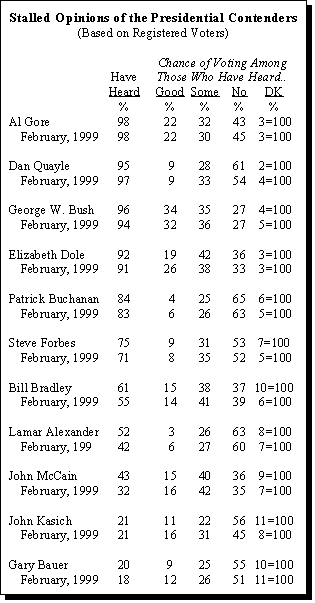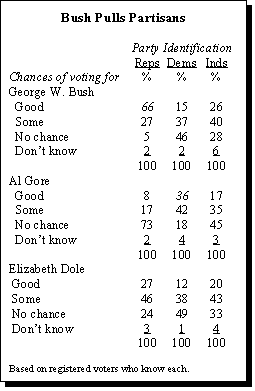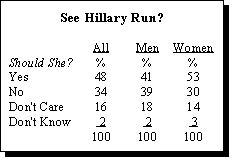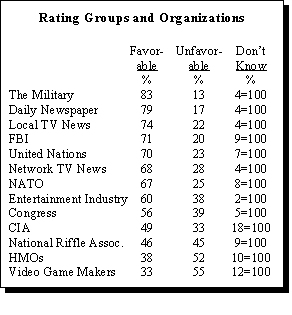Presidential Politics
For all the support Democrats get on the issues, interest in continuing the policies and programs of the Clinton administration has begun to ebb. As the Clinton administration enters its final 18 months, Americans express less enthusiasm for a continuation of the Clinton policy agenda than they did four months ago.

Just 43% want the next president to offer policies and programs similar to those of the Clinton administration; half say they want someone to offer different policies. This support for new programs is a change from February, when the public favored a continuation of Clinton policies by a 54%-41% margin.
Although the growing public desire for change is evident among all demographic groups, it is especially large among many of the Democrats’ core constituencies. Support for the Clinton agenda has fallen 14 percentage points among women, 19 percentage points among senior citizens and 21 percentage points among the less well-educated. Support has even slumped among rank and file Democrats — dropping to 65% now from 83% in February. (See table, page 12.)
Americans are looking for an even bigger break from Clinton’s personal qualities. More than eight-in-ten want the next president to have different personal strengths and weaknesses than those held by the current president; just 12% say they would like to see the next president have similar traits. Rejection of Clinton personally is also up somewhat since February, when the public favored different personal qualities by a margin of 78%-17%.
Voters Unmoved
Desire for a change in the White House, however, has not translated into increased support for any of the leading candidates. Voters are no more likely to consider casting their ballots for Bill Bradley, George W. Bush or Elizabeth Dole than they were one month ago.
Bush continues to lead the pack of Republican candidates, with 34% of registered voters saying there is a good chance they would vote for the Texas governor and another 35% saying there is some chance they’ll vote for him. Yet, despite a flurry of media attention at the beginning of his campaign, this endorsement of Bush shows no signs of movement over the past month. In May, 34% of voters said there was a good chance they would vote for him; 34% said there was some chance.

The story hasn’t changed for Dole, either. Now, 61% of voters would consider voting for her; in May, 63% said so. Dole’s support remains weaker than Bush’s, with about one-in-five voters saying there is a good chance they will back her at the polls, compared to 34% who say the same of Bush.
The former Red Cross president draws more support from Republicans who favor gun control than those who oppose regulation, however. About one-third (31%) of Republicans who support gun control say there is a good chance they will vote for her, compared to 22% of Republican opponents to gun control.
Other well known candidates — Steve Forbes, Patrick Buchanan, and Dan Quayle — continue to flounder. Over half of voters say there is no chance they will vote for Forbes, 61% reject a vote for Quayle and two-thirds (65%) oppose Buchanan.
Among the lesser-known Republicans, only John McCain has gained name recognition: 43% of voters have heard of the Arizona senator, up from 36% in May. Just over half of those who know him say they would consider voting for McCain, a number that has held steady as he has become better known.
Al Gore is the one exception to this pattern of stability. About half (54%) of voters say they would consider voting for the vice president, up somewhat from 47% who said so in May. But even this movement is slight: Gore now stands where he did in February when 52% of voters said there was at least some chance they would vote for him. However, at this point, Gore falls just behind Clinton’s October 1995 standing, in which 56% of voters said they might vote for him.
And, despite attention to Bradley’s campaign, the former New Jersey senator has gained neither name recognition nor potential support. Six-in-ten voters have heard of the NBA star, the same number that knew of him in May. And, just about half (53%) say they would consider voting for Bradley, a figure also unchanged over the past month.
Voter Apathy
Stalled candidate ratings are not surprising given public inattention to news about the 2000 presidential campaign. Just one-in-ten Americans are following election stories very closely. Fully one-third are totally tuning campaign news out.
The disinterest is widespread, equally evident among men and women, blacks and whites, the college educated and those whose education ended with high school. Interest is somewhat above average among Republicans, who will be selecting a nominee from a crowded field of potential candidates. Almost one-in-five (18%) Republicans are following election news stories very closely, compared to 10% of Democrats and just 7% of Independents.
Accordingly, only one-in-ten voters can name an issue or policy that they associate with Bradley; 16% identify an issue with Dole and just 20% can provide a substantive policy for Bush. Gore’s agenda is somewhat more familiar, but even he draws policy responses from only one-third of voters.
When voters think of Gore’s policies, they think of the environment — 17% volunteered this issue. The top issue for the other three candidates is the one in the news lately: guns. Five percent of the public associates this issue with Bradley, 3% for Bush and 3% for Dole.
GOP Behind Bush

Despite the differences in knowledge about the two frontrunners, Republican Bush draws considerably stronger support — and more partisan loyalty — than his chief Democratic rival. Over 90% of Republican voters say they would consider voting for Bush; 78% of Democrats are as open to Gore. And, while two-thirds of GOP voters say there is a good chance they will vote for the Texas governor, about one-third (36%) of Democratic voters are as enthusiastic about their leading man.
Dole runs a distant second among Republicans, 27% of whom say there is a good chance they will vote for her.
Bush is also much more appealing to registered voters outside of his party than is Gore. Over half (52%) of Democratic voters say there is at least some chance they would vote for Bush, while almost three-quarters (73%) of Republicans say there is no chance they will cast a ballot for the vice president.
Bush does better than Gore with Independent voters, as well. Two-thirds would consider voting for him, compared to 52% who say there’s some chance of voting for Gore.
Similarly, among those who favor Republicans for Congress in 2000, fully 63% say there is a good chance they will vote for Bush. But, among those who favor Democrats, only one-third (35%) give this strong an endorsement to their party’s frontrunner.
The Man of This Hour
When asked to choose what leading candidate they would most like to see featured in an in-depth news magazine program, 30% of Americans say Bush. The Texas governor draws three times the interest given Bradley, and twice the number who would like to watch a show on Dole, Gore or Hillary Clinton. A program about McCain garners top interest from only 5% of the public.
Men are decidedly more inclined than are women to express interest in a news magazine show about Bush. Over one-third (36%) of men say they would like to see a program about him, compared to 26% of women. Instead, women are more interested in programs about the two women candidates. A television show on Hillary Clinton is the top pick for 21% of women, but just 10% of men. Similarly, a feature on Dole would draw 19% of women but only 8% of men.
The Texas governor is also the clear favorite among rank and file Republicans. Over half (54%) of Republicans say they would choose a program about him, compared to just 16% who express interest in Dole. Democrats are more divided. About one-quarter expresses interest in a show about Gore — the same number who would like to see a television program about the first lady. Indeed, Bush is almost as interesting to Democrats as is the vice president: 18% of Democrats opt for a program about the Republican.
Hillary’s New York Race
Overall, the public isn’t paying much attention to Hillary Clinton’s possible run for a Senate seat from New York, either. Only a plurality would like to see her be a candidate, and those most interested include minorities, women under age 30 and people from lower income households.

The first lady’s political ambitions are being followed very closely by only 14% of the public, roughly the same number who are following the 2000 presidential election (11%). In comparison, gun control is drawing the very close attention of 28% of the public; the Chinese spying scandal, 21%.
Just 48% of the public wants Mrs. Clinton to run for the Senate, while one-third (34%) says they would rather she didn’t run. Interest in a Clinton candidacy comes mostly from younger women and minority groups. A clear majority (66%) of women ages 18 to 29 want the first lady to run and, while 43% of whites favor a Clinton candidacy, seven-in-ten non-whites do so. Support among those with a family income of more than $75,000 is 37% compared to 55% in households with incomes less than $30,000.
Littleton Lingers
In the aftermath of the high school shootings in Littleton, Colorado, social issues take center stage today. When asked to name the most important problem facing the nation, the public most frequently chooses crime, gangs, the justice system (11%) as well as morality, ethics or family values (11%) and education (7%).
Neither traditional pocketbook matters nor international issues are in the forefront of American minds. Only 5% mention the war in Kosovo as the most important problem today and just 3% specifically volunteer the economy. Even when looking at economic issues collectively, only 8% of the public volunteers an issue such as the economy or jobs that fits this category, down from 16% a year ago and 28% four years ago.

From a list of 13 groups and organizations, video game manufacturers were judged most harshly: Only 33% view game makers favorably; 55% unfavorably. The public is evenly divided (46%-45%) about the National Rifle Association, though opinion varies little from previous years. Hollywood gets a more positive rating: 60% view the motion picture industry favorably, while 38% consider it unfavorably.
Women are more negative about video game makers than are men. Less than half (48%) of men view those manufacturers as unfavorable while a solid majority of women (63%) see that group unfavorably. Additionally, 57% of younger people — those between ages 18 and 30 — view video game makers positively, compared to only 14% of those ages 65 and older. Partisan differences are few in evaluations of video game manufacturers. More than half (52%) of Republicans and 62% of Democrats dislike them.
Almost eight-in-ten (79%) Americans under age 30 rate the entertainment industry as favorable — a number that decreases as age increases. Half of the 50-64 age group give the industry a favorable rating while 35% of seniors level that judgment. Clinton supporters have a more positive opinion about the entertainment industry, with 67% of this group giving that industry a favorable rating. Again, however, there are only minor partisan differences, with 58% of Republicans and 62% of Democrats giving Hollywood a favorable judgment.
NATO Image Improves
The public’s view of NATO has improved substantially in the wake of the conflict with Serbia. Two-thirds of Americans (67%) have a favorable opinion of NATO today, up from 53% in September 1998. While support for NATO is strongest among those who believe the U.S. and its allies achieved their goals with the air attacks against Serbia (77% favorable), fully 60% of even those who think the goals were not achieved have a favorable opinion of NATO.
The military continues to draw high marks, as well. Fully 83% of Americans have a favorable opinion of the military, about the same as a year ago. Some 70% view the United Nations favorably.
China Worries
As the 2000 elections approach, China looms as a potential issue. Amid growing awareness of the charges that China stole nuclear secrets from the U.S. and increased concern about U.S.-China relations, a majority of Americans now express dissatisfaction with the way the Clinton administration has handled China.
China is increasingly on the minds of Americans: a remarkable 67% now volunteer China as the country accused of stealing nuclear secrets from the United States, up from 46% in March 1999. Similarly, 55% of the public says they are following news of the charges at least fairly closely, compared to 42% in May 1999.
Among those following news of the spying charges against China, 45% say that the secrets China stole from the U.S. represent a major threat to U.S. national security; 44% say a minor threat; and 6% say no threat at all. More generally, a slim 53% majority of Americans now say that China is a serious problem, although just 18% consider China an outright adversary.
More than one-third of the public (35%) now says that relations between the U.S. and China are getting worse, up sharply from 19% in March of this year. Half say that relations are staying about the same and less than one-in-ten people (7%) say relations between the two countries are getting better.
Get Tougher

Dissatisfaction with the Clinton administration’s handling of China has grown over the past several months. A 51% majority now says the administration has not been tough enough in dealing with China, compared to 44% who felt this way in March. Republicans are particularly critical of the administration’s China policy: 62% of them say the administration has not been tough enough. Almost as many Independents — 57% — share this view, compared to only 39% of Democrats.
To a lesser extent, the public says that the U.S. should favor a firm stance on human rights in China (49%) over cooperation with the Asian giant to maintain peace and prevent the spread of nuclear weapons in the region (37%). The public was divided 45%-44% on this question in March.
On trade, public opinion is less clear. Opinion splits over whether the U.S. should maintain normal trade relations with China (43%) or contain China’s growth as a military power (44%). At the same time, a clear majority says that the U.S. should not grant China normal trade relations treatment (57% say no; 29% say yes).
Among the 39% minority who think that trade between China and Western nations will lead to China becoming more democratic, support for normal trade relations treatment is stronger — nearly half of this group (48%) favor granting China normal trade relations treatment, compared to only 20% among those who do not make this link.